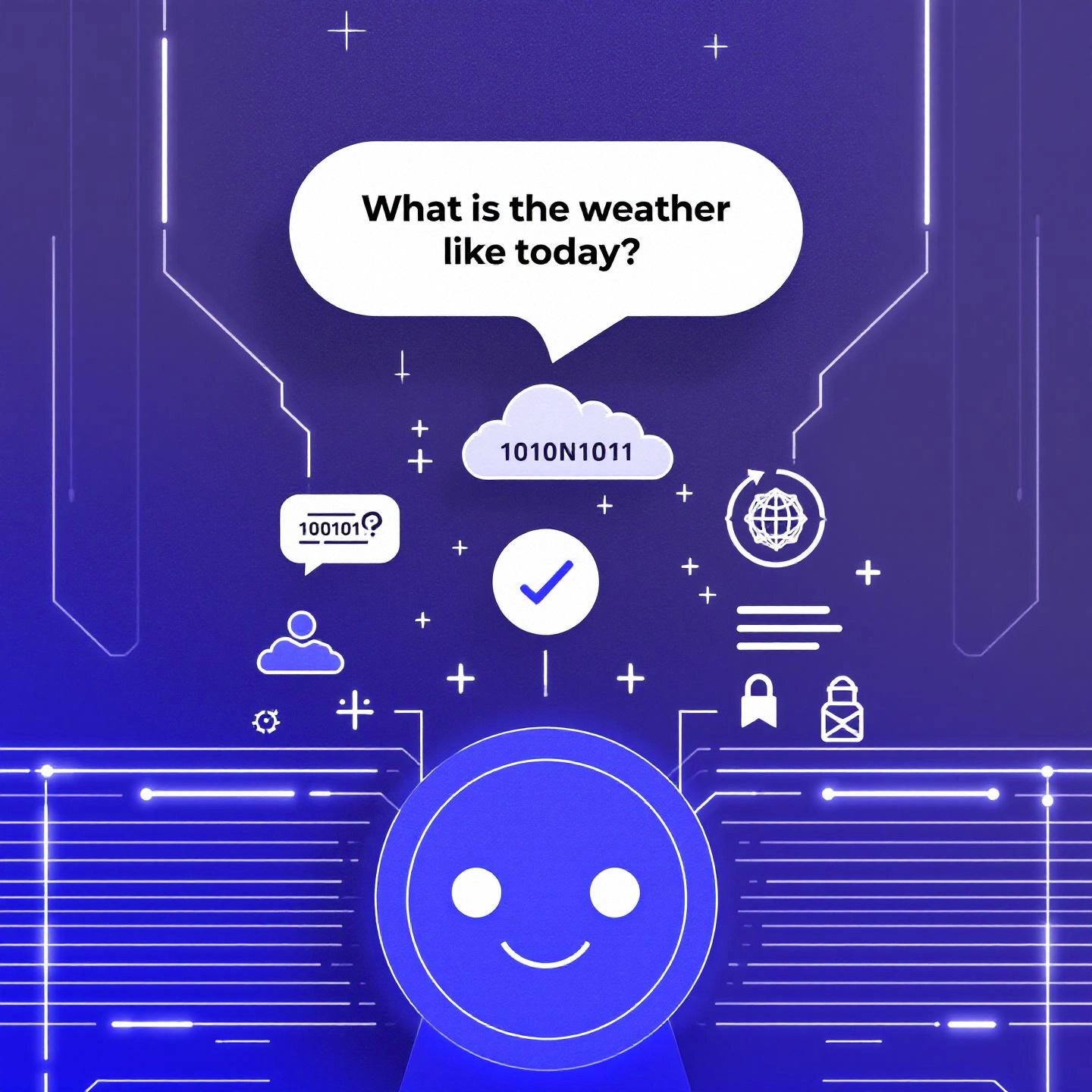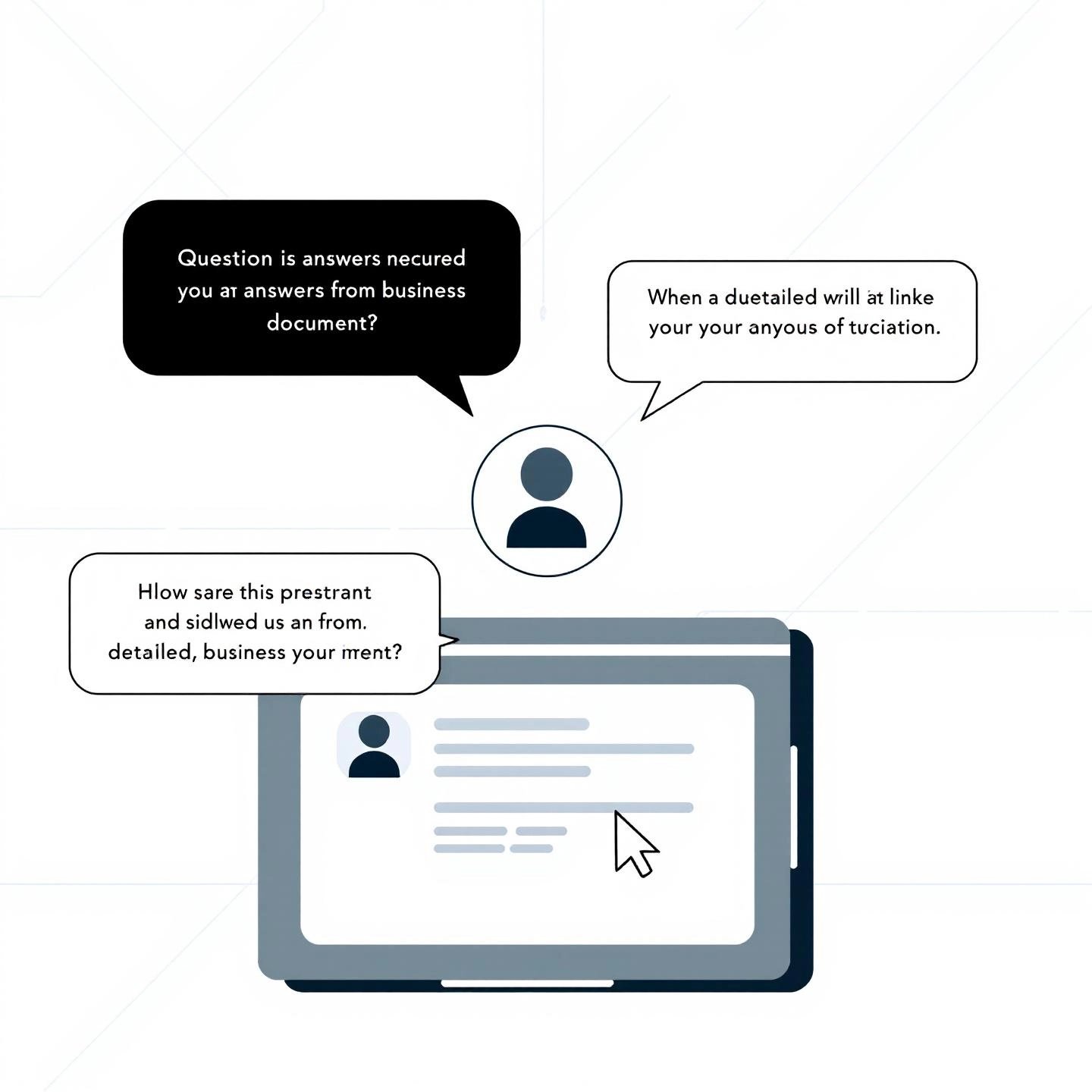How AI Answers Questions Is Transforming Business Problem-Solving
When you think about getting answers for your business—whether it’s helping a customer, training a new employee, or brainstorming fresh content—how do you picture the process? Not long ago, you might have relied on search engines or endless FAQ documents. But today, the phrase "ai answers questions" isn’t science fiction. It's a real, practical tool that’s changing the way businesses operate every single day.
From Search Engines to Conversational AI: A Quick Evolution
Sounds complex? Let’s break it down. Early business tools were limited to basic search engines or rule-based systems. These could only respond to simple, pre-set queries—think of a website chatbot that only knows how to answer “What are your business hours?” If you asked a slightly different question, you’d hit a dead end. These systems were reliable for routine tasks but struggled with anything outside their script, making them hard to scale as business needs grew.
Fast forward to today, and you’ll notice a dramatic shift. Modern AI, powered by advanced natural language processing (NLP) and machine learning, can interpret context, intent, and even sentiment. Conversational AI—like the chatbots and virtual assistants you see on leading business websites—can handle complex, multi-layered questions. They don’t just follow scripts; they learn from interactions and adapt over time, making every conversation smarter than the last (Kommunicate).
Why Businesses Are Embracing AI Question Answering
Imagine a customer service agent that never sleeps, a knowledge base that updates itself, or a content assistant that generates new ideas on demand. That’s the reality for businesses leveraging AI question answering tools. Here’s what they’re gaining:
- 24/7 Customer Support: AI can resolve up to 80% of customer queries automatically, freeing up human agents for higher-value work (Zendesk).
- Internal Knowledge Management: AI systems help employees find answers quickly, reducing onboarding time and supporting faster decision-making.
- Scalable Content Creation: AI generates FAQs, help articles, and even creative content, allowing businesses to scale their digital presence without extra headcount.
- Personalized Interactions: By analyzing previous conversations and contextual cues, AI delivers tailored responses that feel more human and relevant.
Setting the Stage for Strategic AI Adoption
Today’s "ai question answering" solutions are no longer just about automating repetitive tasks. They offer a strategic advantage—helping businesses innovate, respond faster to market changes, and deliver better customer experiences. As AI continues to evolve, companies of all sizes can now tap into tools that were once limited to tech giants, making advanced question answering accessible, customizable, and ready for real-world business challenges.
In the next sections, we’ll dive deeper into how these systems work, the best tools available, and how you can use AI to supercharge everything from support to content creation. Ready to see what’s possible when AI answers questions for your business?

How Modern AI Question Answering Works
Ever wondered how a virtual assistant seems to “get” your question and deliver a surprisingly relevant answer in seconds? The secret sauce behind modern ai question answering isn’t magic—it’s a blend of sophisticated technologies working together in real time. Let’s break down the process so you can see exactly how these systems turn your questions into actionable business answers.
Step 1: Query Understanding—Decoding What You Really Mean
When you type or speak a question, the first challenge for any question answering AI is to figure out what you’re actually asking. This is where Natural Language Processing (NLP) comes into play. NLP algorithms analyze your input, breaking it down into its core components—identifying verbs, nouns, and the relationships between them. But it doesn’t stop there. Modern systems go further by interpreting context, understanding idioms, slang, and even correcting for typos or ambiguous language. For example, if you ask, “What’s the weather like?” the AI uses context (like your location or previous queries) to tailor the response, rather than just offering a generic weather definition.
- Rule-based approaches use predefined patterns to spot keywords or intent.
- Statistical methods weigh the importance of words based on their frequency and position.
- Machine learning models—especially neural networks—learn from huge datasets to recognize intent and nuance, even in complex or unusual queries.
- Hybrid techniques often combine these methods for higher accuracy.
This deep understanding is what lets AI handle everything from simple facts to long, multi-part business questions.
Step 2: Information Retrieval—Finding the Right Data
Once the intent is clear, the AI must fetch the best possible answer. This step involves searching through vast databases, which might include company documents, product manuals, emails, or the entire web. The breadth and quality of the data source matter—a tool trained on your internal knowledge base will answer differently than one using public data. The AI uses algorithms to rank and select the most relevant pieces of information, ensuring responses are both accurate and specific (Tettra).
- Structured data: Organized information, like spreadsheets or databases, yields fast, precise answers.
- Unstructured data: Documents, emails, and chat logs require the AI to sift through and interpret context.
- Contextual awareness: The system remembers previous interactions, allowing for more natural, multi-turn conversations.
Imagine asking, “What’s our refund policy?” The AI scans your company handbook and past support tickets, pulling the most relevant, up-to-date answer.
Step 3: Answer Synthesis—Crafting a Human-Like Response
Here’s where things get impressive. Rather than just copying and pasting a snippet, advanced AI synthesizes information into a coherent, conversational response. It considers tone, clarity, and even your business’s brand voice. This is what separates generic AI output—often robotic or vague—from answers that feel tailored and trustworthy. For example, a well-designed system won’t just say, “Refunds take 5 days.” It might add, “You’ll receive your refund within 5 business days, and we’ll notify you by email once it’s processed.”
- Personalization: Drawing on user data and past interactions to make answers more relevant.
- Multi-lingual support: Many systems can respond in different languages, expanding access.
- Brand alignment: For businesses, AI can be trained to reflect company values and preferred terminology.
Ultimately, the best ai question answering tools don’t just deliver facts—they provide context-rich, brand-aligned solutions that help customers and employees alike.
Generic vs. Brand-Aligned Answers: Why It Matters
Ever notice how some AI responses feel generic, while others sound like they came from your own team? That’s the difference between a system trained on public data and one customized with your business’s unique knowledge base and tone. For critical business interactions—like support, onboarding, or sales—strategically crafted, brand-aligned answers build trust and deliver a more consistent experience.
Understanding these steps sets the stage for choosing the right AI tools for your business needs. Next, we’ll explore how to evaluate and select the best question-answering platforms for everything from rapid content ideation to instant customer support.
Finding the Right General-Purpose AI Question Answerer for Your Business
When you’re searching for an ai question answerer that can handle everything from brainstorming blog ideas to providing instant answers for your team, the options can feel overwhelming. Do you need a tool that’s lightning-fast, one that integrates seamlessly with your existing systems, or something that’s cost-effective for large teams? Let’s break down how to choose the right ai to answer questions—and see how today’s top platforms compare.
What Should You Look for in an AI Question Answering Platform?
Imagine you’re tasked with improving your company’s internal knowledge base or need to support customers around the clock. The right AI can make these goals achievable, but only if you select a solution that fits your business. Here are the key factors to consider:
- Accuracy & Relevance: Does the AI deliver precise, context-aware answers?
- Speed & Scalability: Can it handle high volumes and respond in real time?
- Integration: Is it easy to connect with your current tools, databases, or workflows?
- Customization: Can you tailor the AI’s responses to match your brand voice and specific needs?
- Security & Privacy: Does the platform protect your data and comply with relevant regulations?
- Pricing: Does the cost align with your expected usage and value delivered?
Keeping these criteria in mind will help you match the right AI solution to your business goals—whether that’s automating support, accelerating research, or generating content ideas.
Comparison Table: Top AI Question Answering Platforms
To make your decision easier, here’s a side-by-side look at some of the most popular platforms businesses are using today. Each offers unique strengths, so think about which features matter most for your workflow:
| Platform | Best Use Cases | Key Features |
|---|---|---|
| Copilot | Automated support, internal Q&A, content research | Real-time, high-accuracy answers; seamless integration; analytics; customizable; user-friendly |
| ChatGPT (OpenAI) | Content ideation, conversational support, creative writing | Conversational AI; supports multiple languages; customizable bots; advanced reasoning |
| Claude (Anthropic) | Data analysis, code generation, large document processing | High token limit; emotional intelligence; fast, nuanced answers |
| Perplexity | Research, fact-checking, web search with citations | Summarized, source-cited answers; advanced search filters |
| Microsoft Copilot | Conversational search, image generation, Windows integration | Text, image, and voice input; integrates with Microsoft ecosystem |
| Google Gemini | Google Workspace integration, document Q&A, image analysis | Fast answers; connects to Gmail, Maps, and more; image uploads |
| IBM Watson | Enterprise Q&A, multilingual support, analytics | Language translation; sentiment analysis; scalable APIs |
| Amazon Lex | Conversational bots, voice/text support, AWS integration | Speech recognition; NLP; easy deployment |
How to Match the Best AI to Your Business Needs
Still unsure which ai question answerer is right for you? Consider these quick scenarios:
- Need rapid content ideas? ChatGPT, Copilot, or Claude are strong choices for creative brainstorming and drafting.
- Handling customer support at scale? Copilot, Microsoft Copilot, or IBM Watson offer robust integration and analytics for enterprise environments.
- Research and source-checking? Perplexity and Gemini excel at pulling in up-to-date, cited information from across the web.
- Custom workflow integration? Amazon Lex and IBM Watson provide powerful APIs for developers and IT teams.
Ultimately, the best ai to answer questions should fit your workflow, scale with your needs, and deliver reliable, brand-aligned answers. By comparing features, use cases, and pricing, you’ll be able to make a confident, informed choice that supports your business goals now and as you grow (Copilot). In the next section, we’ll spotlight top free AI platforms for instant answers—ideal for experimentation, small teams, or anyone just starting out with AI-powered Q&A.
Top Free AI Platforms for Instant Answers
Ever found yourself stuck on a tricky question or needing a fast answer without digging through endless web pages? That’s where ai that answers questions free comes in. Whether you’re a business leader, a student, or just curious, there are now dozens of free ai question answer tools designed to deliver instant, clear responses. But how do these platforms stack up—and what should you watch out for when using them for business?
Leading Free AI Tools for Answering Questions
Let’s break down some of the most popular and versatile free AI platforms available today, along with their strengths and best use cases:
- AI Blaze: Instantly answers questions on any website, provides detailed explanations, and works with text, images, and documents. Ideal for quick research, homework help, or reviewing business materials. 100% free and requires no subscription.
- ChatGPT: Great for brainstorming, writing, and general Q&A. It’s conversational, supports multiple tones, and is easy to use on desktop or mobile. Perfect for content drafts, email replies, or creative ideation.
- Claude: A direct competitor to ChatGPT, Claude specializes in technical topics, coding, and realistic conversations. It’s popular for summarizing meeting notes or generating formulas.
- Perplexity: Stands out for research-driven, up-to-date answers with cited sources. Great for fact-checking, industry research, or when you need to trust the data behind the answer.
- Gemini (Google): Powered by real-time information and integrated with Google apps. Excellent for business research, document Q&A, and up-to-date market insights.
- Merlin AI: Browser extension that works across any website, allowing you to highlight text or upload images for instant answers. Handy for on-the-fly research or reviewing articles.
- AnswersAI: Designed for uploading PDFs, notes, or screenshots—then asking questions about them. Useful for reviewing business documents, contracts, or summarizing reports
Benefits of Free AI Question Answer Tools
- Zero cost: Experiment with multiple tools without budget concerns. Perfect for small businesses or teams just starting with AI.
- Speed and convenience: Get answers in seconds—no need to wait for human support or dig through documentation.
- Versatility: Many tools handle text, images, PDFs, or even video-based questions, making them suitable for a variety of business scenarios.
- Low-risk experimentation: Test workflows, automate repetitive queries, or try out new AI-powered processes before committing to a paid solution.
Limitations and Risks of Free AI Tools
- Privacy and data security: Free tools often use your inputs to train their models. Sensitive business data could be stored or repurposed, so avoid uploading confidential information (Mitrix).
- Reliability: Free platforms may have usage caps, slower response times, or unexpected downtime. If your business depends on uninterrupted service, these tools can become bottlenecks.
- Limited customization: Most free AI question answer tools provide generic responses and lack brand voice alignment or deep workflow integration.
- Scalability: As your needs grow, you may outgrow the free tier and need to migrate to a paid or more robust solution.
When Should Businesses Use Free AI Platforms?
Free AI tools are ideal for:
- Ad-hoc research or quick fact-checking
- Experimenting with AI-powered workflows before investing
- Supporting small teams or solo entrepreneurs on a tight budget
- Learning and training purposes
However, for business-critical tasks—like handling sensitive customer data or automating customer-facing support—consider the risks and plan for a scalable, secure upgrade path.
Ready to take the next step? In the following section, we’ll show how to use AI not just for answers, but for generating structured Q&A content and scaling your business knowledge base.

Using an AI Question Answer Generator to Build Your Business Knowledge Base
Ever wished you could create a full set of FAQs or knowledge base articles for your business—without spending days brainstorming, writing, and editing? That’s where an ai question answer generator comes in. These advanced tools don’t just answer questions; they help you generate both the questions and the answers, streamlining content creation and supercharging your SEO efforts. Let’s explore how this works and why it’s a game-changer for businesses of all sizes.
How AI Question Generators Work: Turning Topics into Structured Q&A
Sounds complex? Here’s how the process usually unfolds:
- Step 1: Input Your Topic or ContentStart by providing the AI with a topic, a block of text, or even a URL to your website or documentation. The more context you give, the better the results—think product pages, service descriptions, or internal guides.
- Step 2: AI Analyzes and Extracts Key InformationThe ai question generator uses natural language processing and machine learning to scan your input, identify important details, and anticipate the questions your audience is likely to ask.
- Step 3: Generate Relevant Questions and AnswersWith a click, the AI creates a list of question-and-answer pairs tailored to your content. You can often select the number of Q&As, the tone of voice (professional, friendly, humorous), and even the language for global audiences.
- Step 4: Review, Edit, and Fine-TuneMost tools let you review the generated content, edit questions or answers for accuracy, and regenerate any that need improvement. This ensures your Q&A matches your brand and business context.
- Step 5: Publish or IntegrateCopy the output directly into your website, help center, or knowledge base. Some platforms support direct integration with content management systems or knowledge base software.
Why Use an AI Question Answer Generator?
Imagine the time and effort saved compared to manual research and writing. Here are the key benefits for businesses:
- Scale Content Creation: Quickly produce FAQs, help articles, onboarding guides, or troubleshooting docs, even if you have limited staff or technical expertise.
- Improve SEO: Well-structured Q&A content is favored by search engines and is more likely to be cited in AI-generated search results, boosting your online visibility.
- Enhance Customer Experience: Provide instant, accurate answers to common questions, reducing support tickets and improving satisfaction.
- Consistency Across Channels: Ensure your messaging and information remain consistent, whether on your website, in chatbots, or across support materials.
- Multilingual Support: Easily generate Q&A content in multiple languages to reach a global audience.
Practical Examples: AI-Driven Q&A for Every Business Need
Not sure where to start? Here are some common use cases that illustrate the versatility of an ai question answer generator:
- Product FAQs: Generate questions about specifications, compatibility, and unique features from your product descriptions.
- Ordering & Shipping: Address common concerns around order customization, delivery times, and returns by prompting the AI with your e-commerce policies.
- Technical Troubleshooting: Turn installation guides or user manuals into step-by-step Q&A for self-service support.
- Subscription & Billing: Clarify pricing plans, payment methods, and account management with clear, AI-generated answers.
- Knowledge Base Expansion: Convert existing articles or documentation into structured questions and answers for easier navigation and discovery.
Tips for Getting the Most from Your AI Q&A Generator
- Be specific with your prompts—provide detailed context for better results.
- Choose the tone and language that best fits your brand and audience.
- Review and edit generated content to ensure accuracy and brand alignment.
- Regularly update your Q&A as products, services, or policies change.
By leveraging an ai question answer generator, you can build a robust, scalable knowledge base that empowers both your customers and your team—while also boosting your SEO and online authority. Next, we’ll look at how AI can take things even further by analyzing video content and extracting answers from webinars, podcasts, and more.

AI That Can Watch Videos and Answer Questions
Ever wished you could ask a video a question and get a direct answer—without scrubbing through hours of footage? With ai that can watch videos and answer questions, that vision is now a reality. Businesses today face a tidal wave of video content: webinars, meetings, marketing clips, training sessions, and podcasts. But how do you turn all that raw footage into actionable insights, summaries, and new content? Let’s explore how ai video question answering is changing the game for organizations of every size.
How AI Video Question Answering Works
Sounds complex? Here’s the simple version. Video Question Answering (VideoQA) uses advanced AI models to analyze both the visual and audio streams of a video. The AI doesn’t just transcribe speech—it identifies objects, actions, and even emotions, building a rich understanding of what’s happening on screen. When you ask a question, the AI scans through the entire video, processes context, and delivers a precise answer in real time. This is a huge leap from manual tagging or keyword searches, making it possible to interact with videos as easily as you do with text (Eden AI).
Business Applications: Where AI Video QA Delivers Value
Imagine the possibilities when your team can ask questions about any video and get instant, reliable answers. Here are just a few high-impact use cases:
- Summarizing Webinars and Meetings: AI quickly condenses hour-long sessions into concise summaries, highlighting key points and action items. No more manual note-taking or missed details (Notta).
- Generating Articles from Video Podcasts: Turn video conversations into polished blog posts, newsletters, or social media snippets—helping you reach audiences who prefer reading over watching.
- Creating Show Notes and Action Lists: Instantly extract timestamps, speaker highlights, and actionable next steps from marketing videos or internal training sessions.
- Building Searchable Video Knowledge Bases: Enable employees or customers to search for answers within your video library as easily as searching a document.
- Translating and Localizing Content: AI can transcribe, summarize, and even translate videos into multiple languages for global reach and compliance.
- Extracting Quotes and Testimonials: Find and repurpose authentic moments from interviews, webinars, or customer stories for use in sales, marketing, or training.
Repurposing Video Content: Multiply Your ROI
When you repurpose video content with AI, you’re not just saving time—you’re multiplying the value of every recording. Here’s how:
- Boost Content Output: One webinar can become blog posts, infographics, social media clips, and more—all generated with minimal manual effort.
- Increase Audience Reach: By offering content in different formats (text, audio, video), you cater to diverse preferences and expand your brand’s footprint.
- Enhance Accessibility: AI-generated transcripts and summaries make your content usable for those who prefer reading or have accessibility needs.
- Improve Knowledge Retention: Summaries and action items help teams remember and act on what matters most—without rewatching lengthy videos.
Choosing the Right AI Video QA Tool
What should you look for in an ai video question answering solution? Here are a few pointers:
- Accuracy: Look for tools with high transcription and summary accuracy—some, like Notta, boast up to 98.86% accuracy rates.
- Customization: The best tools allow you to tailor summaries, highlight key moments, or focus on specific speakers or topics.
- Integration: Make sure the tool works with your existing platforms—like Zoom, Google Meet, or your CMS.
- Speed and Scalability: Choose solutions that process videos quickly and can handle your content volume.
Leading providers like Google Cloud (via Eden AI) offer powerful VideoQA APIs, while platforms such as Notta, Mindgrasp, and Contrast provide user-friendly interfaces for business users.
Strategic Advantage: Why AI Video QA Matters for Business
Ultimately, AI video question answering is about more than just saving time. It’s about unlocking the full value of your video assets—making them searchable, actionable, and reusable across your business. By transforming videos into structured knowledge, you empower teams to work smarter, create more content, and drive better results from every piece of footage you capture.
In the next section, we’ll explore how AI can support interview preparation—helping you generate questions, simulate mock interviews, and provide actionable feedback for candidates and HR teams alike.
Preparing for Interviews with AI Assistance
Ever felt unprepared walking into an interview, unsure of what questions might come your way or how best to answer them? You’re not alone. Whether you’re a candidate aiming to land your dream job or an HR professional seeking to streamline the hiring process, ai interview questions and answers tools are transforming how we prepare for interviews—and making the process less stressful and more effective for everyone involved.
How AI Powers Interview Preparation
Sounds complex? Let’s break it down. AI for interview preparation typically works in three main stages:
- Generating Tailored Interview Questions: Instead of relying on generic lists, modern AI tools analyze the specifics of a job description or candidate profile to create custom interview questions. For example, you can paste a job description into an AI-powered generator and instantly receive behavioral and technical questions relevant to the role and industry. This ensures every interview is targeted and comprehensive, whether you’re hiring for entry-level or executive positions.
- Simulating Mock Interviews: Imagine practicing your responses in a realistic, low-pressure environment. AI platforms now let users record answers (via text or audio) and simulate the back-and-forth of a real interview. This not only builds confidence but also helps candidates refine their communication skills and timing.
- Providing Actionable Feedback: After each practice session, AI reviews your responses and offers instant coaching. Leveraging frameworks like STAR (Situation, Task, Action, Result), the AI highlights strengths and suggests specific improvements—sometimes even providing sample answers for comparison. This feedback loop helps both candidates and HR professionals identify gaps and sharpen their approach.
Versatility in HR and Professional Development
AI’s role in interview preparation doesn’t stop at question generation. Here’s how these tools are making an impact across HR and learning functions:
- For Recruiters and Hiring Managers: Save hours of manual research by using AI to craft relevant, role-specific questions that align with your company’s values and priorities. This leads to more consistent, fair, and insightful interviews (Reed).
- For Job Seekers: Practice answering realistic questions, receive immediate feedback, and reduce anxiety—especially valuable for those new to the workforce or switching careers.
- For HR Development: Use AI to identify common skills gaps, personalize training, and support continuous improvement in communication and critical thinking skills (AIHR).
Practical Example: AI-Driven Interview Prep in Action
Imagine you’re preparing for a project manager interview. By inputting the job description into an AI tool, you receive a set of questions focused on leadership, conflict resolution, and project delivery. You then record your answers, and the AI provides feedback, such as, “Try elaborating on the impact of your actions,” or “Include more measurable results in your response.” This iterative practice helps you polish your answers and gain confidence before the real thing.
Why AI Interview Preparation Matters for Businesses
- Consistency: Ensures every candidate is evaluated with relevant, unbiased questions.
- Efficiency: Reduces preparation time for both candidates and hiring teams.
- Personalization: Adapts questions and feedback to specific roles, industries, and seniority levels.
- Scalability: Supports large-scale hiring and training initiatives without sacrificing quality.
AI interview preparation tools aren’t just about answering questions—they’re about empowering people to put their best foot forward, while helping businesses find the right talent faster and more fairly. As we move forward, it’s essential to recognize both the strengths and the limitations of these systems. In the next section, we’ll explore the boundaries of AI’s knowledge and why human oversight remains critical for business success.
The Search for an AI That Can Answer Any Question
Imagine asking an AI any question—about your business, your customers, or even the world—and expecting a perfect, reliable answer every time. Sounds futuristic, right? But as AI becomes more deeply woven into business operations, it’s easy to assume these systems are infallible. The reality is more nuanced. While ai that can answer any question is a powerful goal, today’s technology comes with important limitations that every business must understand to use it effectively and safely.
Why AI Can’t Know Everything: The Limits of Today’s Technology
Let’s start with a simple truth: No AI system, no matter how advanced, truly “knows everything.” Instead, AI models draw on patterns in the data they’ve been trained on, plus any external sources they’re connected to. If you ask about something outside their data set—or about a brand-new event—they may produce incomplete, outdated, or even incorrect answers. This gap is often called the "AI accuracy limitation".
- Routine vs. Novel Tasks: AI excels at routine, well-defined tasks—like summarizing FAQs or analyzing structured data. But when faced with novel, high-risk, or creative problems, human judgment is still essential. As one expert notes, “AI can act as a production assistant, but not as the director. Not yet.” (Async Agile)
- The Turing Trap: There’s a common misconception that the goal of AI should be to perfectly imitate human intelligence. In reality, the most value comes from using AI to augment human strengths, not replace them. By focusing too much on making AI "human-like," businesses risk missing out on unique advantages—like processing vast data sets or synthesizing information across sources.
Understanding Hallucinations: When AI Gets It Wrong
Ever received an answer from AI that sounded convincing—but turned out to be completely made up? This phenomenon is known as an AI "hallucination." It happens when the system generates plausible-sounding responses that aren’t grounded in real data. Hallucinations can occur for several reasons:
- The AI lacks up-to-date or relevant data on the topic.
- The prompt is ambiguous, leading the model to "fill in the blanks."
- The system is pressured to provide an answer, even when it should say “I don’t know.”
For business-critical applications, these errors can introduce real risks—such as sharing inaccurate policy information or misrepresenting your brand. That’s why it’s crucial to frame AI outputs as imperfect and build in processes for quality assurance and feedback (phData).
The Essential Role of Human Oversight
So, how do you harness the strengths of AI while protecting your business from its pitfalls? The answer is skilled human oversight. Here’s what that looks like in practice:
- Quality Control: Always review AI-generated answers—especially for public-facing content or important business decisions.
- System Management: Set up checkpoints and clear criteria for when human intervention is required. Use tools that make it easy to track, audit, and refine AI outputs over time.
- Ethics and Transparency: Be transparent with users about when and how AI is used, and set clear standards for fairness and accountability.
- Continuous Improvement: Collect feedback from your team and customers to identify errors, improve prompts, and adapt workflows as technology evolves.
AI as a Tool—Not a Replacement
Think of AI as a crane, not a loom. It’s here to extend your team’s capabilities, not to replace the need for human judgment or creativity. By pairing AI’s speed and data-processing power with human expertise, businesses can achieve more reliable, ethical, and impactful results. As you continue exploring how ai answers questions for your organization, remember: the best outcomes come from collaboration—not blind trust in technology.
In the next section, we’ll explore practical ways to improve the quality of AI-generated answers, including prompt engineering techniques that help you get the most accurate and useful responses.

Phrasing Questions to Get Better AI Responses
Ever wondered why sometimes AI gives you exactly what you need, while other times the answers feel off or miss the mark? The difference often comes down to how you phrase your questions. This is the heart of ai prompt engineering—a set of techniques that can dramatically improve ai answers for your business. Let’s break down how you can get more accurate, relevant, and actionable responses from any AI tool.
Why Prompt Engineering Matters
Imagine asking a colleague, “Can you help?” versus, “Can you create a summary of last quarter’s sales trends in a bullet-point list, using a friendly tone for our marketing team?” Which request is more likely to get you the result you want? AI works the same way: the clearer and more specific your prompt, the better the output.
Key Elements for Crafting Effective AI Prompts
Sounds complex? Here are four actionable areas you can focus on to master prompt engineering and get the most out of AI:
- Provide Context
- Always include background details. Specify the task, audience, or scenario to help AI interpret your intent.
- Example: Instead of “Write a guide,” try “Write a beginner’s guide to using our mobile app, aimed at new customers.”
- Define Persona and Tone
- Ask the AI to respond as a particular role (like a product manager or technical writer) and set the tone (formal, friendly, concise, etc.).
- Example: “Act as a customer support agent. Explain our refund policy in a reassuring and professional tone.”
- Specify Desired Format
- Clarify how you want the answer delivered—such as a list, table, summary, or step-by-step guide. This helps the AI organize information logically.
- Example: “Summarize the main features of our product in a 5-bullet list.”
- Iterate and Refine
- Don’t settle for the first answer. Provide feedback, ask follow-up questions, or rephrase your prompt for more detail or clarity.
- Example: “Can you elaborate on point three?” or “Rewrite this answer in a more persuasive style.”
Pro Tips for Better AI Interactions
- Be specific, not vague: The more detailed your prompt, the more relevant the response.
- Use examples or templates: If you have a preferred style or format, provide a sample for the AI to mimic.
- Set constraints: Limit word count, request citations, or specify what to include and what to avoid.
- Break down complex tasks: Use step-by-step instructions or chain of thought prompts to guide the AI through multi-part problems (Google Cloud).
Sample Prompt Engineering Checklist
| Prompt Element | Why It Matters | Example |
|---|---|---|
| Context | Ensures relevance and accuracy | "Summarize our privacy policy for customers." |
| Persona/Tone | Aligns with brand and audience | "Respond as a friendly HR manager." |
| Format | Makes answers actionable | "List three steps in a table." |
| Iteration | Refines and improves output | "Expand on the second point." |
Making AI Work for Your Business
By focusing on these prompt engineering strategies, you’ll notice a dramatic improvement in how ai answers questions for your business. Better prompts mean better answers—helping you save time, reduce confusion, and get insights that truly drive results. As you continue to develop your AI workflows, remember: effective prompting is a skill anyone can learn, and it’s the key to unlocking AI’s full potential.
Ready to put these tips into practice? In our final section, we’ll recap the business value of AI-powered Q&A and share how a thoughtful content strategy can maximize your results.
Conclusion
When you picture the future of business, do you see teams bogged down by repetitive questions, or a streamlined operation where answers flow instantly and content creation scales with demand? The difference often comes down to how effectively you leverage ai answers for business. As we’ve explored, today’s AI tools aren’t just about automating responses—they’re reshaping how organizations solve problems, engage customers, and build their digital presence.
AI’s Versatile Role in Modern Business
Sounds ambitious? Let’s recap the core ways AI is delivering value right now:
- General Q&A and Support: AI-powered chatbots and assistants provide 24/7 answers to customer and employee questions, reducing wait times and freeing up your team for strategic work. This leads to higher satisfaction and operational efficiency (UC Online).
- Content Generation at Scale: From FAQs to blog posts and knowledge base articles, AI automates the creation of high-quality, SEO-optimized content. This not only saves time but also helps businesses stay competitive in fast-moving markets.
- Video Analysis and Repurposing: Advanced AI can watch, transcribe, and summarize video content, turning webinars and meetings into searchable knowledge assets and new content formats. This unlocks new ways to engage audiences and maximize your investment in video.
But here’s the catch—while AI can accelerate results, it’s not a “set and forget” solution. The real power comes from pairing smart technology with a thoughtful ai content strategy and ongoing human oversight.
Why Human Strategy Still Matters
Imagine launching an AI-driven help center or content hub without a clear plan. You might generate lots of answers, but will they align with your brand, meet customer needs, or support your business goals? That’s where strategic planning and skilled oversight come in. As highlighted by industry leaders, AI is most effective when guided by humans who:
- Set clear objectives and performance metrics for AI-driven initiatives
- Regularly review and refine AI-generated answers for accuracy, tone, and brand alignment
- Integrate AI insights with broader business processes and customer feedback
- Ensure compliance, privacy, and ethical standards are maintained
By keeping humans in the loop, businesses can avoid common pitfalls—like AI hallucinations or off-brand messaging—and build trust with both customers and employees.
Maximizing Results with AI-Driven Content Strategy
So, how do you unlock the full potential of ai answers for business? Here are a few actionable steps:
- Start with Clear Use Cases: Identify where AI can have the biggest impact—customer support, internal knowledge sharing, or content marketing.
- Choose the Right Tools: Select AI platforms that fit your workflow, data privacy needs, and integration requirements.
- Invest in Training: Upskill your team to work alongside AI, focusing on prompt engineering and content review skills.
- Measure and Optimize: Track performance metrics and continuously refine your approach based on real-world outcomes.
For many businesses, partnering with expert services can accelerate this journey. Solutions like BlogSpark offer an end-to-end platform for AI-powered content creation, keyword discovery, and workflow integration—making it easier to scale your content and stay ahead of the competition without a steep learning curve.
Looking Ahead: AI as a Growth Catalyst
As AI continues to evolve, the opportunities for businesses will only expand. By combining smart technology with human insight and a robust ai content strategy, you can transform everyday questions into engines of growth, innovation, and customer loyalty. The future belongs to those who use AI not just to answer questions, but to ask better ones—and to turn those answers into meaningful business results.
Frequently Asked Questions About AI Answers Questions
1. How does AI answer business questions differently from traditional search engines?
AI leverages advanced natural language processing to understand context and intent, allowing it to deliver tailored, conversational responses. Unlike traditional search engines that provide a list of links, AI synthesizes information from vast data sources, creating brand-aligned answers that address complex business needs directly.
2. What are the best free AI tools for answering questions in a business setting?
Popular free AI tools include ChatGPT, Claude, Perplexity, Gemini, and Merlin AI. Each offers instant question answering, but businesses should consider privacy, customization, and scalability before relying on free solutions for critical operations.
3. Can AI generate both questions and answers for business knowledge bases?
Yes, AI question answer generators can analyze your content, extract key topics, and create structured Q&A pairs. This streamlines the creation of FAQs and knowledge base articles, improving SEO and customer support efficiency.
4. How reliable are AI-generated answers, and what are their limitations?
While AI delivers fast, relevant answers, it can sometimes produce errors or 'hallucinations' when data is lacking. Human oversight is essential for fact-checking, especially for business-critical content, to ensure accuracy and maintain brand trust.
5. How can businesses improve the accuracy of AI-generated responses?
Businesses can enhance AI output by providing clear context, specifying desired tone and format, and iterating prompts. Regular review and prompt engineering help align answers with business goals and brand voice.




